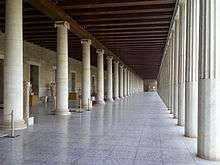Stoa

A stoa (/ˈstoʊə/; plural, stoas,[1] stoai,[1] or stoae /ˈstoʊ.iː/[2]), in ancient Greek architecture, is a covered walkway or portico, commonly for public use. Early stoas were open at the entrance with columns, usually of the Doric order, lining the side of the building; they created a safe, enveloping, protective atmosphere.
Later examples were built as two stories, with a roof supporting the inner colonnades where shops or sometimes offices were located. They followed Ionic architecture. These buildings were open to the public; merchants could sell their goods, artists could display their artwork, and religious gatherings could take place. Stoas usually surrounded the marketplaces or agora of large cities and were used as a framing device. [3]
The name of the Stoic school of philosophy derives from "stoa".
Famous stoae

- Stoa Poikile, "Painted Porch", from which the philosophy Stoicism takes its name
- Stoa of Attalos
- Stoa Basileios (Royal Stoa)
- Stoa of Zeus at Athens
- Stoa Amphiaraion
- Stoa of the Athenians
See also
References
External links
| Look up stoa in Wiktionary, the free dictionary. |
- YASOU
 "Stoa". Encyclopædia Britannica (11th ed.). 1911.
"Stoa". Encyclopædia Britannica (11th ed.). 1911.